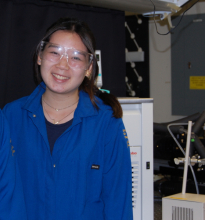
Major:
University:
Mentor(s):
Faculty Sponsor(s):
Faculty Sponsor's Department(s):
Project Title:
Project Description:
Thermoresponsive colloidal gels are composed of a network of small particles with a temperature-sensitive attractive interaction potential. These gels present a wide range of drug delivery, biomimetic, and other industrial applications because of their potential to produce microporous soft materials, tuned by the strength of attraction between particles. An understanding of droplet-droplet interactions is thus crucial in controlling the characteristics of the material formed. The nanoemulsions studied were comprised of silicone oil (polydimethylsiloxane - PDMS) nanodroplets in an aqueous poly(ethylene glycol) diacrylate (PEGDA) polymer and surfactant solution. Photopolymerization of PEGDA can occur over a range of temperatures, facilitating tunable gel porosity based on temperature-sensitive droplet-droplet attraction strengths. The oil volume fractions (φ) and dilution solvent were established for which the second virial coefficient (B2), a function of the droplet-droplet interaction potential, could be measured across a range of temperatures. The measured B2 values were also compared to those predicted by theoretical models. The range of φ over which B2 could be evaluated was determined for each solvent by measuring a wide range of concentrations with static light scattering (SLS) and observing the lowest value of φ at which the background scattering of the solvent was overcome, as well as the highest value at which the SLS equipment could function. Holding the concentration of polymer constant proved the most effective dilution method, allowing B2 to be measured as a function of temperature. However, experimentally obtained B2 values diverged significantly from those predicted by theory even after consideration of electrostatic interactions and experimental approach, suggesting that further examination of additional particle interactions or of the equipment used is necessary.
